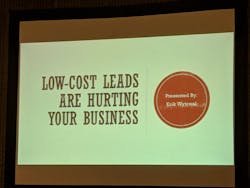AHR 2019 Session: Low Cost Leads are Hurting Your Business
ATLANTA — "Low Cost Leads are Hurting Your Business" was a free session presented by Erik Wytrwal under the sponsorship of Women in HVACR at AHR Expo 2019. Wytrwal is a consultant with Stochastic Marketing, a data analytics company designed specifically with HVACR and plumbing contractors in mind. ("Stochastic" means "to aim with precision.")
One of the things that distinguishes Stochastic is that they get a lot of information from their customers, then turn around and use that information to refine the models and strategies they create. The company gets twelve years of data (if the company has. been in business that long) from each customer. Zip codes, actual invoices, pricing data and more. The wealth of information allows them to examine trends, both for individual companies and industry-wide.
The total now approaches something close to nine or ten billion dollars worth in HVACR and plumbing transactions. Almost all the data is residential.
The company's focus is on cost per call/cost per lead analysis. Basically, what does it cost a contractor to acquire a new customer. There are a lot of different way to count a lead. Is it a phone call? A call that results in a visit? A call that results in a sale? The rise of the internet has only complicated the matter. Is a click on a link the same thing as a lead? Is filling out an online form?
And partly because leads have become so easy to get these days, there is a.tendency to value the quantity of leads over their quality. All leads, however, are not created equal. Some houses are just worth more than others.
Successful contractors do most of their marketing -- and most of their jobs -- in two or three zip codes close to their place of business
Also, contractors tend to over-value the lifetime worth of a customer (placing it somewhere in the $15,000 to $20,000 range). In fact, the average lifetime value of an HVAC customer is $2,679. A plumbing customer just $1,055. For a dual business, $2,669.
Another important consideration: when do contractors actually get paid? 60 percent of all the money an HVAC contractor will see out of a customer comes in the first year. After that it rapidly falls off: 17 percent in years two through three, another 17 percent after year four. Plumbers -- on average -- actually get 73 percent of all the money they will see out of a customer in the first year.
Equally important is where contractors get paid. Successful contractors do most of their marketing -- and most of their jobs -- in two or three zip codes close to their place of business. Wytrwal strongly suggests that contractors should be focused on one or two zip codes per million dollars in sales. And he advises against trying to market in the affluent areas, if those areas are outside your immediate range of business. Why? That marketing is only going to benefit the contractors who already have brand recognition in the area.
Chasing a higher volume of low quality leads -- leads which have not been modeled, which do not take into account customer demographics and geography -- means a higher volume of calls worth $500 or less. The effect on a business is a slow erosion. A drop in the lifetime value of customers. More overhead; vans aren't free; gas isn't free; techs need to get paid. Higher marketing costs (you need to generate more leads to get the same amount of money). And perhaps most critically, increased technician turnover. What tech wants to be in van four hours out of the day, running from one sub-$500 job to the next?
So crunch some numbers. Find out your own percentage of sub-$500 customers, and do what you can to better that percentage. Invest in higher quality leads that use modeling. Modeled customers are worth $1,000 more than the average over their lifetime.
